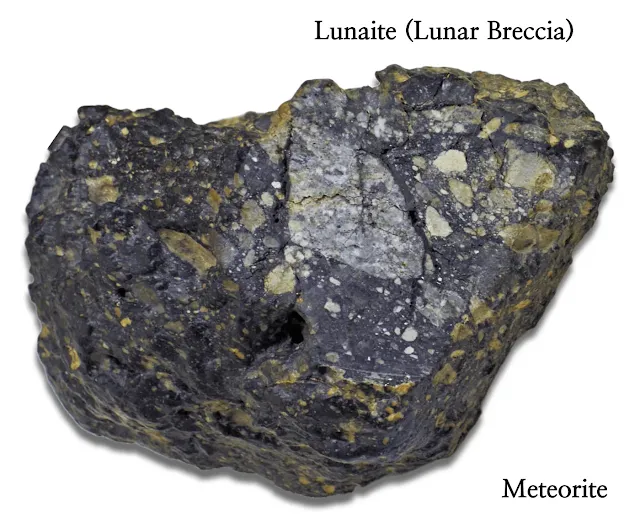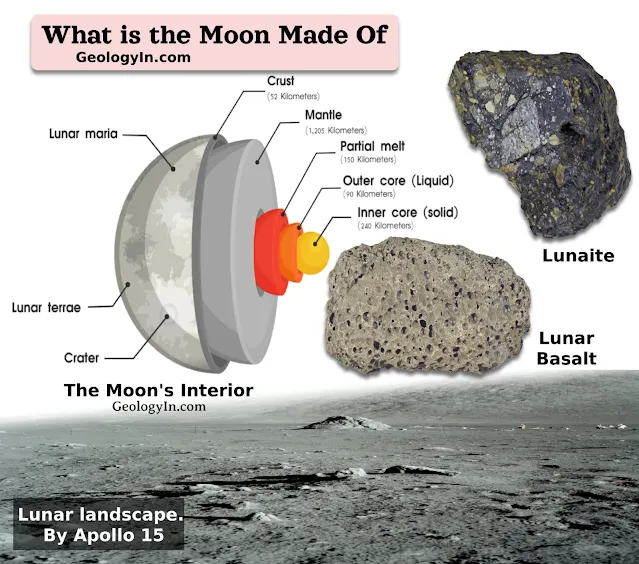What is the Moon Made Of
To the naked eye, the Moon appears gray with striking light and dark patches, yet its simple appearance hides a complex geological reality. A differentiated rocky body, the Moon consists of a small iron-rich core, a silicate mantle, an anorthositic crust, and a regolith surface layer, with trace water ice in polar shadowed craters.
Its composition—rich in oxygen, silicon, magnesium, iron, calcium, and aluminum forming minerals like anorthite and pyroxene—reflects a violent origin, likely from a giant impact with early Earth. Apollo samples, seismic data, and missions like Chandrayaan-1 and LCROSS reveal a history shaped by ancient volcanism and impacts.
The Moon Surface Composition
The lunar surface is dominated by two contrasting terrains: the bright, heavily cratered highlands and the darker, smoother maria (Latin for “seas”). Almost the entire surface is blanketed by a fine “regolith” of pulverized rock and dust. These highlands formed early, accumulating impact debris, while the maria basins were later flooded by basaltic lavas.
Highlands (Anorthositic Crust)
The lunar highlands comprise approximately 83% of the Moon's surface and represent its primordial crust. Key characteristics include:
- Elevation: 1–2 km higher than the maria regions
- Albedo: High reflectivity due to mineral composition
- Crater Density: Extensive cratering from early Solar System bombardment
- Mineralogy: Dominated by anorthosites (a type of intrusive igneous rock), composed of over 90% calcium-rich plagioclase feldspar (anorthite).
- Geochemistry: High aluminum oxide content (Al₂O₃ ~28%) with low iron oxide (FeO 4–6%)
These bright, heavily cratered regions formed during the initial solidification of the lunar magma ocean, when less dense plagioclase crystals floated to the surface to create the original lunar crust.
 |
| Lunar highland anorthosite - intrusive plutonic igneous rock composed of calcium-rich plagioclase feldspar from the Moon's primordial crust, Collected by Apollo 16. |
Maria (Basaltic Plains)
Mare regions cover approximately 17% of the lunar surface, predominantly on the nearside, and appear as darker plains. Their distinctive features include:
- Formation: Large impact basins subsequently filled with basaltic lava flows between 3.1 and 3.9 billion years ago
- Crater Frequency: Lower crater density indicating younger surface age
- Mineralogy: Basaltic composition rich in pyroxene, olivine, and ilmenite
- Geochemistry: High iron oxide content (FeO 15–25%) and variable titanium dioxide (TiO₂, up to 13% in high-titanium basalts)
- Topography: Lower elevation than highlands, filling large impact basins
The mare basalts originated from partial melting of the lunar mantle, with magma reaching the surface through fractures created by large impacts.
 |
Apollo 15: Mare Vesicular basalt with gas cavities, showing lunar volcanic activity in the Moon's dark plains (maria). |
Moon Regolith
The entire lunar surface is covered by a layer of fragmented material known as regolith, formed by continuous meteorite bombardment over billions of years. This layer exhibits:
- Composition: Fine dust (50–70%), rock fragments, impact-generated glass spherules, and breccias
- Thickness: 4–5 meters in mare regions and 10–15 meters in highlands
- Physical Properties: Angular, abrasive particles due to absence of erosional processes
- Chemical Features: Contains solar wind-implanted volatiles (hydrogen, helium); lacks organic material and water-altered minerals
- Elemental Composition: Primarily oxygen (43%), silicon (20%), aluminum (10%), calcium (8%), iron (10%), with trace magnesium, titanium, and sodium
The regolith serves as a historical record of solar system processes and a protective blanket over the underlying bedrock.
 |
Lunar regolith landscape photographed during Apollo 17: Fine impact debris blankets the surface where astronaut Jack Schmitt collected samples. |
Internal Structure of the Moon
Geophysical data from seismic experiments, gravity measurements, and lunar laser ranging reveal the Moon's differentiated internal structure.
Crust
The lunar crust varies significantly in thickness and composition:
- Thickness: 40–60 km on the nearside and 70–100 km on the farside
- Primary Lithologies:Anorthosites (highlands): Predominantly calcium-rich plagioclase feldspar
- Norites and troctolites: Containing orthopyroxene, olivine, and plagioclase
- Impact breccias: Formed through compaction of impact-shattered materials
KREEP Component: Regions enriched in potassium (K), rare earth elements (REE), and phosphorus (P), concentrated primarily in the Procellarum region, representing late-stage crystallization products of the lunar magma ocean.
 |
Lunaite meteorite: Rare lunar breccia found in Mauritania (2014). |
Mantle
The lunar mantle extends to approximately 1,350 km depth and consists primarily of:
- Olivine ((Mg,Fe)₂SiO₄)
- Pyroxenes ((Ca,Mg,Fe)₂Si₂O₆)
- Garnet (at greater depths)
The mantle's bulk composition is estimated at 35–40% MgO, 25–30% SiO₂, and 25–30% FeO. Seismic data indicate a relatively rigid mantle with limited convection, with moonquakes detected at depths of approximately 100 km and 1,000 km suggesting a layered structure.
Core
The Moon possesses a small core with the following properties:
- Radius: 300–400 km (comprising only 1–3% of lunar mass)
- Structure: Differentiated into a solid iron inner core (~240 km radius) and a partially molten outer core
- Composition: Predominantly metallic iron with alloyed nickel and sulfur
- Boundary layer: Possible partially molten silicate layer at the core-mantle interface
The core's relatively small size accounts for the Moon's low bulk density (3.34 g/cm³) and historically weak magnetic field.
Water Ice on the Moon
The Moon’s surface is mostly dry, but water ice exists in permanently shadowed polar craters, such as Cabeus, where temperatures below 110 K prevent sublimation. NASA’s LCROSS (2009) confirmed water ice by analyzing ejecta from a crater impact, while Chandrayaan-1’s Moon Mineralogy Mapper (M³) and LRO’s Lyman Alpha Mapping Project (LAMP) mapped ice as frost or regolith-mixed particles at concentrations of 100–400 ppm.
Trace hydroxyl (a water-related molecule) detected in surface minerals suggests additional volatiles. Likely delivered by comet/meteorite impacts or formed through solar wind interactions with lunar minerals, this ice is a vital resource for future missions, enabling in-situ resource utilization (ISRU) for water, fuel, or life support.
 |
Breccia sample collected by Apollo 16. |
How Does the Moon Compare to Earth?
The Moon differs significantly from Earth:
- Lower density: The Moon's average density (3.34 g/cm³) is substantially lower than Earth's (5.51 g/cm³), reflecting a smaller iron core
- Depleted volatiles: The Moon contains significantly less water and other volatile compounds than Earth
- No atmosphere: The absence of an atmosphere exposes the lunar surface to space weathering processes not present on Earth
- Core size: The Moon's core represents a much smaller proportion of its total mass compared to Earth's core
Unlike Mars, with its iron-rich crust, or Mercury, with a large metallic core, the Moon’s silicate-rich composition and small core reflect its unique formation via the Giant Impact Hypothesis, where debris from a Mars-sized impactor coalesced to form the Moon.
How Do We Know the Moon’s Composition?
Scientists have determined the Moon’s composition through multiple methods:
Apollo Missions (1969–1972): Astronauts collected 382 kg of rocks and regolith, providing direct data on minerals, elements, and isotopic signatures.
Lunar Meteorites: Over 400 meteorites, mostly found in Antarctica and North Africa, reveal the composition of unsampled regions, including the farside.
Remote Sensing: Missions like Clementine (1994), Lunar Prospector (1998–1999), SELENE/Kaguya (2007–2009), and Lunar Reconnaissance Orbiter (2009–present) used spectrometry to map elements (e.g., iron, titanium, aluminum) and minerals.
Recent Missions: China’s Chang’e-4 (2019) landed on the farside and detected mantle-derived olivine and low-calcium pyroxene in the South Pole–Aitken Basin, confirming mantle material excavation. India’s Chandrayaan-1, NASA’s LRO, and LCROSS (2009) confirmed water ice (100–400 ppm) in permanently shadowed polar craters.
These combined efforts have revealed the Moon’s composition, including its volcanic rocks, impact-formed regolith, and traces of water, advancing our understanding of its origin and resources.
 |
Geophone Rock, Lunar surface photography during Apollo 17. |
Frequently Asked Questions
What is the Moon primarily made of?
Are there metals or rare elements on the Moon?
Is there water on the Moon?
Finally, The Moon’s composition comprises a silicate-rich crust (anorthositic highlands, basaltic maria), an olivine- and pyroxene-dominated mantle, and a small iron-rich core. The regolith, modified by impacts and solar wind, reflects underlying bedrock.
Read also:
Geology Of Moon
How to Identify Meteorites With Pictures



%20(1).webp)





